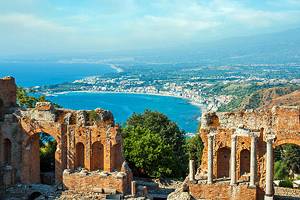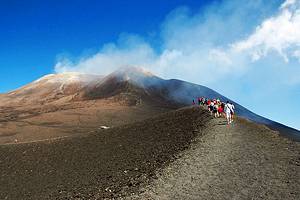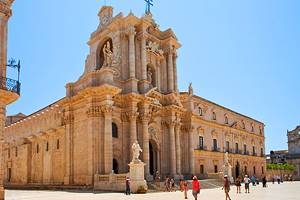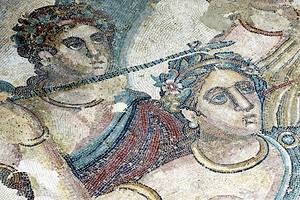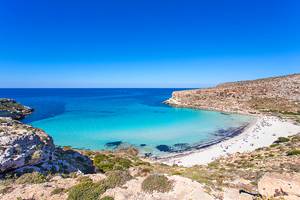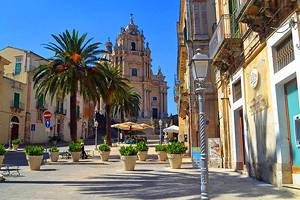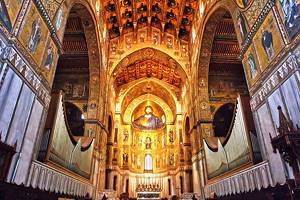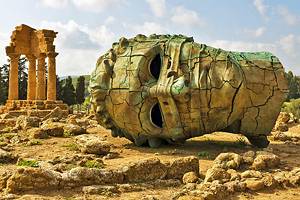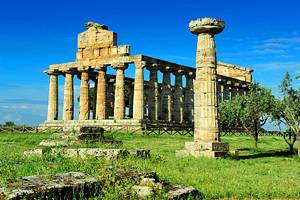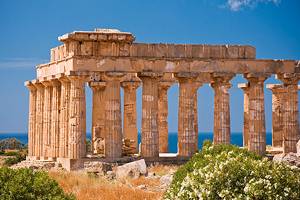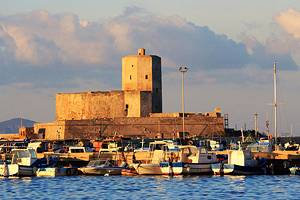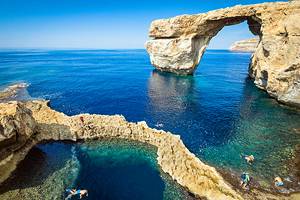Tourist Attractions in Messina
Messina, the third biggest city in Sicily after Palermo and Catania, is the place where rail and car travelers first set foot on Sicilian soil. It is also a popular cruise port.
Messina's well-protected natural harbor and its position on the Strait of Messina, close to the mainland, have determined the city's history from the earliest times. But its location as the gateway to Sicily has also meant that tourists tend to hurry through it on their way to the many other attractions of the island.
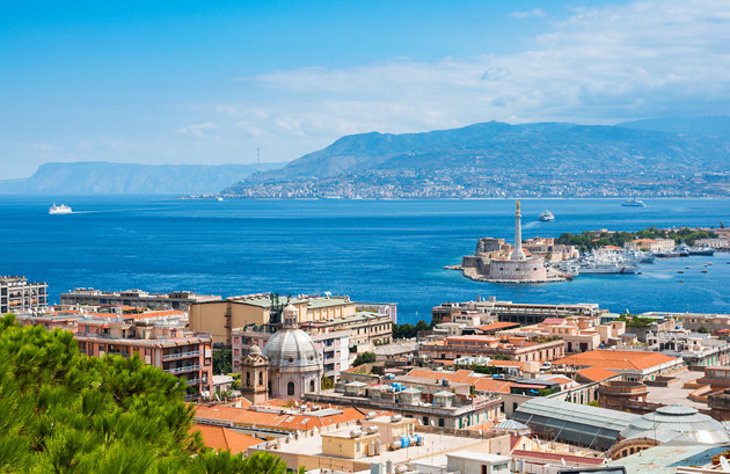
Messina deserves a place on any Sicilian itinerary for its many things to see and do, and for a chance to meet its upbeat, friendly inhabitants, perhaps during one of the lively festivals that fill its streets with music and color. The most colorful of these is Vara, each August 15, when a 15-meter-tall statue of the Madonna weighing nearly eight tons is carried in procession through the streets.
To be sure you don't miss any of the best places to visit, use this handy list of the top attractions in Messina.
- Cathedral and the Piazza del Duomo
- The Bell Tower and Astronomical Clock
- Santissima Annunziata dei Catalani
- Regional Museum
- Fontana di Orion (Orion Fountain)
- Fontana di Nettuno (Neptune Fountain)
- Panoramic Road and Sacrario di Cristo Re
- Scenic Drive to Torre di Faro
- Camposanto
- Madonnina
- Galleria Vittorio Emanuele III
- More Things to See and Do
Cathedral and the Piazza del Duomo
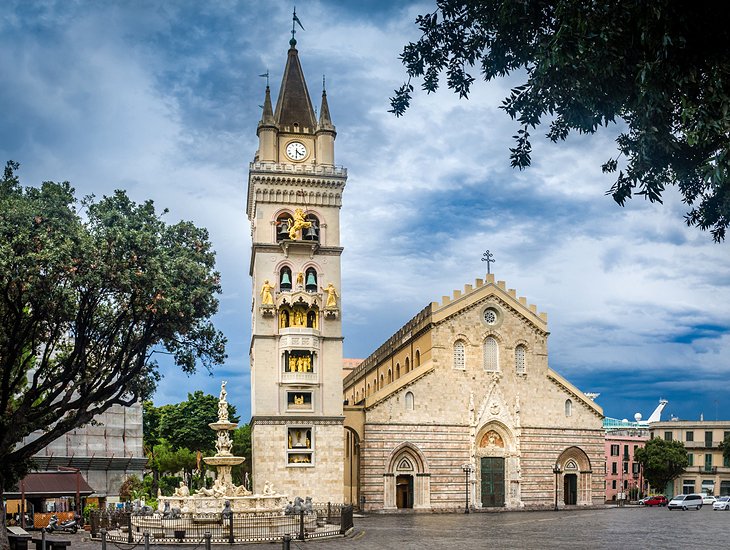
The cathedral forms one end of the wide Piazza del Duomo, Messina's historic center, and in front of it is the Orion fountain. On the left long side of the cathedral stands the Baroque column of the Virgin Mary by Giuseppe Buceti, erected in 1758.
The church was built in the 1100s by the Normans, who ruled Sicily at the time, but it was seriously damaged by an earthquake that devastated much of Messina in 1908. Barely recovered from that, the cathedral was again severely damaged by World War II bombing.
Following both, the reconstruction remained true to the original form and retained important later features such as the carved stone portals from the late Gothic period, medieval relief carvings on the lower facade, and three apses on the east side that date from its founding.
Like all Norman cathedrals in Sicily, the cathedral is a columned basilica with three aisles, a transept, and three apses. The monumental interior has a brightly colored roof truss and arcades with pointed arches; the apse mosaics of the enthroned Christ are reconstructions, as are the apostle altars of the side aisles.
Through all its travails, this remains one of Sicily's finest cathedrals.
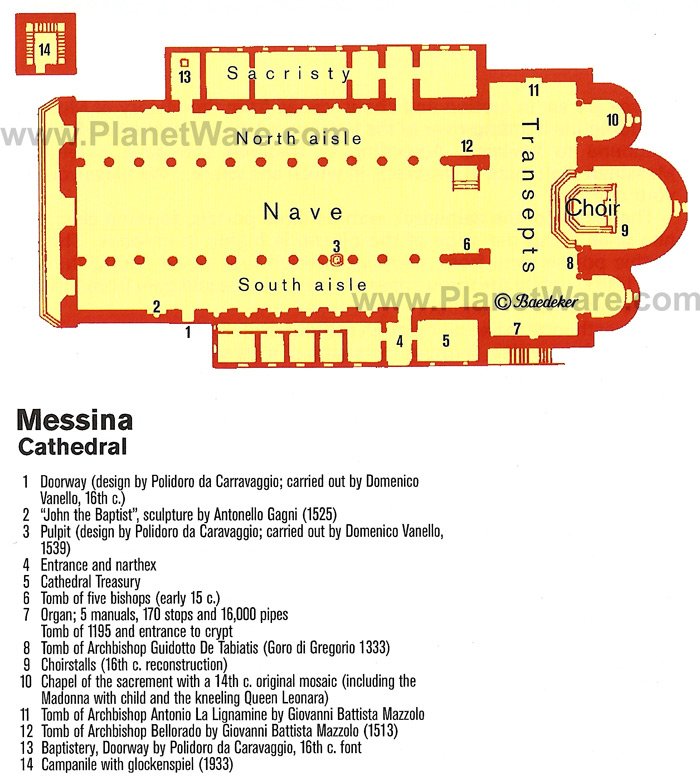
The Bell Tower and Astronomical Clock

This 60-meter high bell-tower, reconstructed using old designs, contains one of the greatest of all astronomical clocks, a work by the Strasbourg firm of Ungerer placed there in 1933.
Every day at noon (or sometimes shortly after) the figures begin moving and show scenes from the history of Messina, including the handing-over of the legendary letter of protection from the Madonna to Messina.
The show begins with a gilded lion waving a banner and roaring, and the action continues for 15 minutes with animated figures popping out of windows. On the side of the tower facing the church façade, a clock face shows astronomical information.
Santissima Annunziata dei Catalani
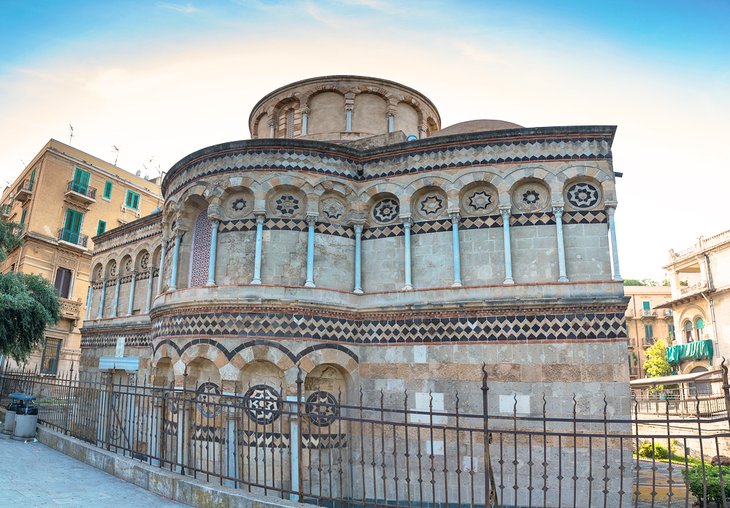
The second most important church in Messina is the Santissima Annunziata dei Catalani. It is the only building to have survived the earthquake of 1908, but was not so fortunate in the World War II bombing. The church was built in the second half of the 12th century under Norman rule, and the east side dates from this time.
The main apse between the transept arms is distinguished by the delicate architectonic arrangement of its false arcades on small elegant columns, and by its multi-colored building materials. The west side with its three portals dates from the 13th century, when the building underwent some alterations.
In the three-aisled interior, stilted arches are supported on columns with a variety of capitals. The central aisle has barrel vaulting, while the side aisles have cross vaulting.
Address: Via Garibaldi Giuseppe 111, Messina
Regional Museum
Each of the three sections of Messina's Regional Museum - the painting gallery, sculpture collection, and archeological section -- contains significant pieces. Sculpture highlights include an Antonello Gagini sculpture of St. Antonius, Francesco Laurana's Madonna with Child, and Goro di Gregorio's Madonna of the Cripples, as well as the originals of the figures on the Fountain of Neptune.
In the Picture Gallery is the "Polyptychon of Saint Gregory" by Antonello da Messina, painted in 1473 but damaged in the earthquake of 1908. Of particular importance are The Worship of the Shepherds and The Raising of Lazarus from the Dead by Caravaggio, and finds from ancient Zancle in the archeology section.
Address: Viale della Liberta 465, Messina
Fontana di Orion (Orion Fountain)
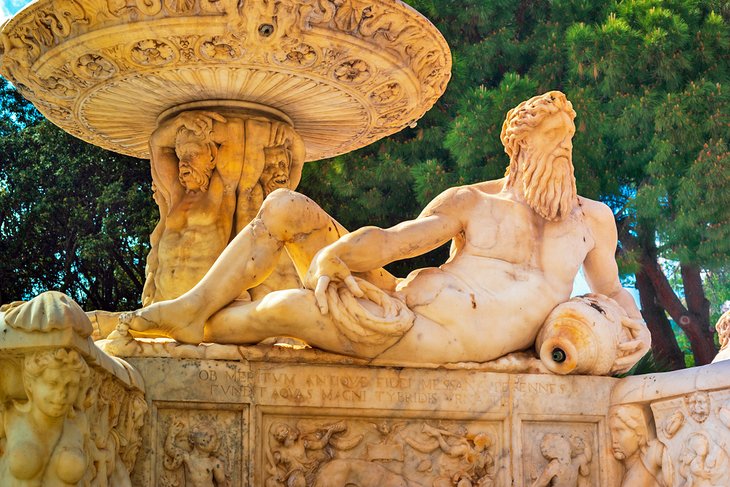
Standing in a prominent position in front of the cathedral in Piazza del Duomo, the Orion statue was created by Giovanni Angelo Montorsoli, a student of Michelangelo in Florence. Montorsoli was assisted by his own student, Martino Montanini, and together they worked on the monumental work between 1547 and 1551.
The monument was commissioned to memorialize the completion of Messina's first aqueduct, in 1547, which accounts for the four rivers represented at its base: the Nile, the Tiber, the Ebro, and the local Camaro, the source for the fountain.
Crowning the pyramid formation is Orion, whom legend holds to be the city's founder. He is portrayed with his dog, Sirius, at his feet.
Renaissance art scholar Bernard Berenson praised the fountain as the most beautiful of its kind, for its design, its artistry, and its fine detail.
Address: Piazza del Duomo, Messina, Sicily
Fontana di Nettuno (Neptune Fountain)
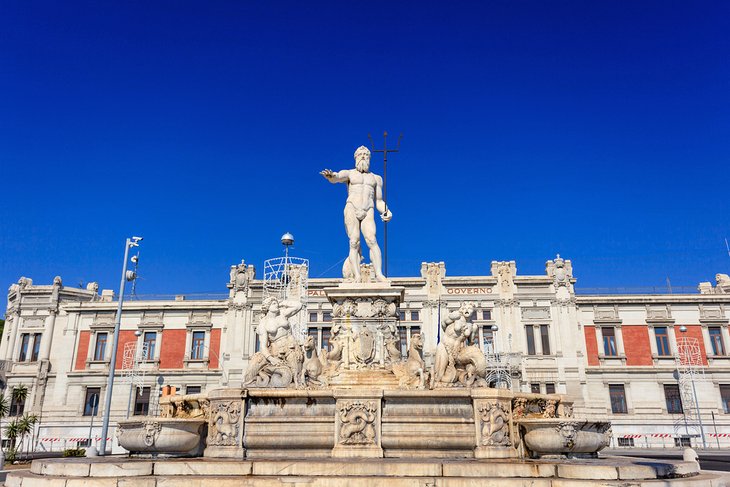
Equally beloved by locals, the Fontana del Nettuno, or Neptune Fountain, is located in a park, set apart from the city center. It was built in 1557 and, like the Orion fountain, is a work of Montorsoli.
The fountain shows the god of the sea caught between Scylla and Charybdis, the two monsters made famous by Homer in The Odyssey as the guards at either side of the Strait of Messina. The Via della Liberta begins at this fountain and leads out of the city towards the exhibition ground of the Fiera di Messina.
Address: Via Giuseppe Garibaldi, Messina
Panoramic Road and Sacrario di Cristo Re
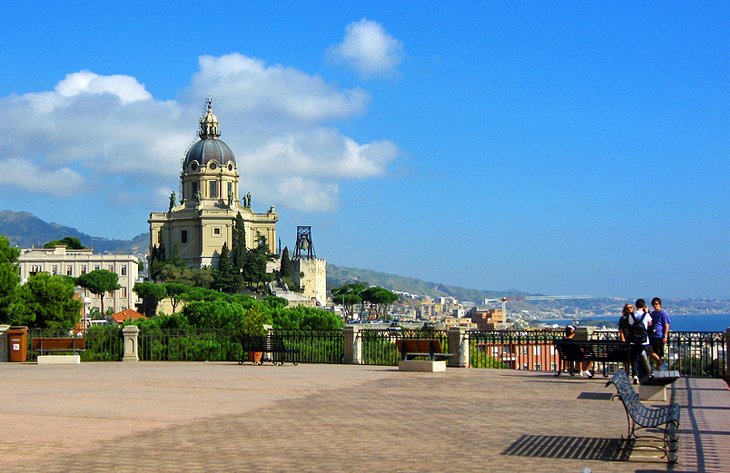
An attractive panoramic route, Viale Italia, begins to the west of the university and continues westwards under varying names (Viale Principe Umberto, Viale Regina Margherita). The walkways and boulevards run above the city, following the course of the old fortifications, and end in the north on the coast road.
The route skirts the Botanic Garden, the rebuilt Santuario di Montalto, and the votive chapel of Sacrario di Cristo Re. This shrine, with its huge octagonal dome, is a memorial to war casualties, and its bell tolls hourly in their memory. Near Prince Umberto Avenue is a beautiful esplanade with panoramic views across the city and harbor.
Address: Viale Principe Umberto 89, Messina
Scenic Drive to Torre di Faro
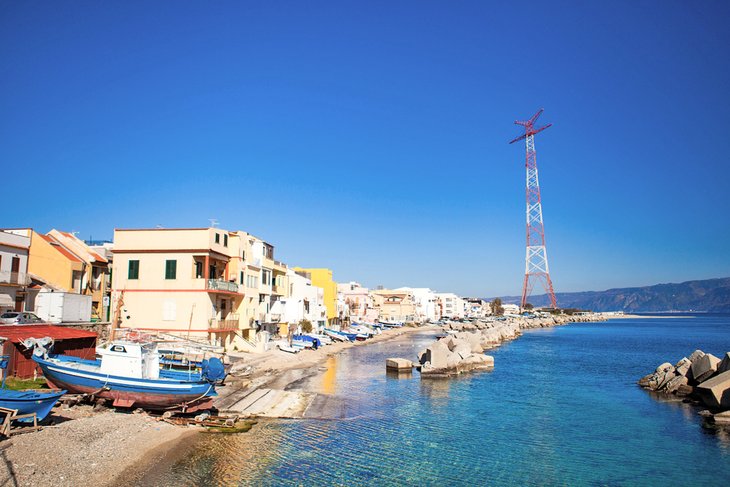
A scenic road runs 15 kilometers along the coast northeast of Messina. Villas and gardens line the route, which passes two salt-water lagoons, the Pantani, also known as the Laghi di Ganzirri. The road eventually comes to the village of Torre di Faro, on the Punta del Faro, Sicily's north-eastern tip.
Enjoying fine views from the lighthouse is one of the most popular things to do here. The 250-meter Pilone, although no longer in use, is a reminder of Italy's post-war industrialization and stands at the entrance to the Straits of Messina. This is the point known in Greek mythology as the lair of Charybdis, and you can see the rock of Scylla across the strait.
From Torre di Faro, the coast road continues around the most northerly cape in Sicily. You can return to Messina over the Colle San Rizzo, which reaches a height of 465 meters.
Camposanto
On the west side of the Piazza Dante is the Camposanto, or Cimitero Monumentale, one of Italy's largest and most beautiful cemeteries. On top of the hill is an Ionic colonnade, the Pantheon of the town's leading citizens, from which there are fine views of the city and the strait.
The Neoclassical, Baroque, Art Nouveau, and Rationalist sculptures and monuments are set in gardens, making it seem more like an open-air art gallery than a cemetery. This was not by accident, as the cemetery was planned as an urban park, and has attracted the works of local and other artists in creating its monuments.
Address: Via Catania, Messina
Madonnina
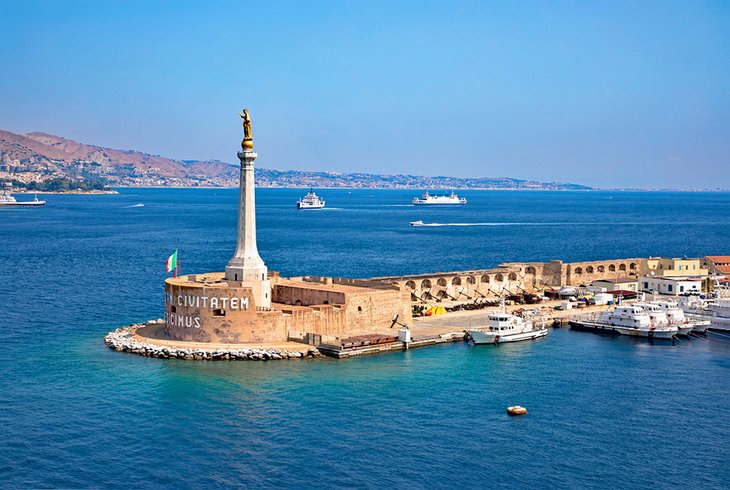
A promontory juts out from the west of Messina into the harbor with the remains of a citadel called the Fort of San Salvatore, which was built in 1681. It forms the base for a 60-meter octagonal column erected in 1934, topped by a statue of the Madonna della Lettera. Locals call it the Madonnina, little Madonna.
Inscribed on the monument is "Vos et ipsam civitatem benedicimus" (We bless you and your city), a quote from a letter the Virgin Mary was believed to have sent the people of Messina. The pillar can be reached on foot by crossing over the tracks at the railroad station, although it is better to use the boat service.
Galleria Vittorio Emanuele III
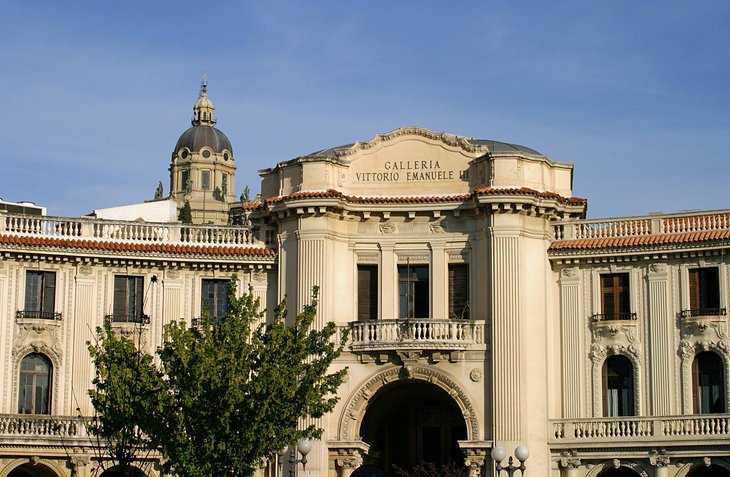
Reminiscent of the grand galleria on Piazza Duomo in Milan, this impressive gallery is also constructed of iron - rare in Italy - but was built later. It opened in 1929, at the same time as the reconstruction of the cathedral.
Like Milan's, it serves as a combination shopping center and stylish salon where locals go to see and be seen in its cafés and restaurants. Inside, the galleria is decorated in stucco work, with a beautiful black and white mosaic floor.
Address: Piazza Antonello, Messina
More Things to See and Do
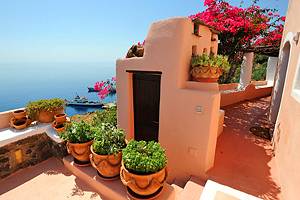
Where to Go near Messina: Some of Italy's finest treasures of the ancient world are easy day trips from Messina. The closest is the Greek Theater in Taormina, and one of the largest theaters in the ancient Greek Empire is in the archaeological park in Syracuse, on the coast south of the city.
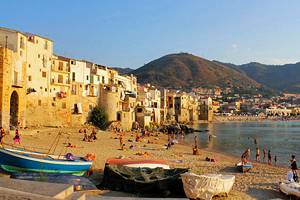
Places to Visit from Messina: Leave the coast to venture inland to Enna, in the center of the island, with one of the best-preserved villas anywhere in the Roman Empire. For beautiful coastal scenery, drive along the north coast, where the mountainous inland drops to the Tyrrhenian Sea, to visit Cefalù. Farther west is Sicily's capital, Palermo, with its mosaic-lined churches.






